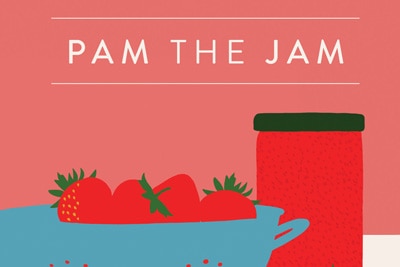A Well Preserved Christmas - Guest Blog by Pam the Jam

Guest Blog by Pam The Jam
With the jingle of Santa’s sleigh bells in the distance, and with little fresh fruit available customarily December, isn’t the month to make preserves. However, with the festive season just around the corner it’s a perfect time to indulge in, and celebrate these jars of joy. For generations past, and very much with a heartfelt ‘waste not, want not’ approach to life these valuable stalwarts of the larder were made using seasonal fruit and veg gluts over the summer, stored away and then enjoyed, spoonful by spoonful, for many months to come. Home-made jams and preserves have been intrinsically linked to the festive season gracing the Christmas table; sometimes the star of the meal, other times simply there to brighten up left overs, but always prized./p>
Sherry Trifle, oozing with the fruitiest of raspberry jam; Christmas morning breakfast croissants dripping with fragrant apricot jam or bitter sweet Seville orange marmalade; pickles and piquant relishes contribute with gusto to the Boxing Day table, whilst cranberries bluster their way into sauces stuffings, ice-creams, puds and tarts. I do have a love-hate relationship with these North American sourpusses, but cannot deny the excellent way in which their sourness offsets the richness and sweetness of the festive season — alternatively, and closer to home, you can use British grown red-currants make bright piquant jelly to use in much the same way.
Times change, lifestyles too with seemingly less kitchen time to pot up and preserve when things are in season, but thankfully we still delight in the formality of tradition — especially at Christmas time — and my Christmas certainly wouldn’t be complete without a cupboard full of preserves. But I don’t always use fresh fruit to make my preserves, and nowadays often use frozen fruit to make my lovely jams — and at any time of the year.
Raspberries make an absolutely gorgeous jam and is a jam I make most often. This recipe is super-easy, quick, highly fruity (about 80 percent fruit) and is as reliable as Christmas is on the 25th December! Using jam sugar, which has pectin and a little citric acid added to it, means you get a good set without overcooking the raspberries and reducing them to a mass of woody pips. It’s not rocket science, and there’s still plenty of time to make a batch or three — some for you and some to give to worthy friends this Christmas time.
My Favourite Raspberry Jam
- 1kg British Frozen Fruit Frozen Raspberries
- 650g jam sugar
- A drop or two of olive oil (if needed)
- Have ready 6 x 200ml sterilised jars and lids
- Put the raspberries in a large heavy-based pan. Lightly sprinkle in the sugar, shaking the pan so the sugar is well distributed. Cover and leave for an hour or so for the juices to draw.
- Lightly stir the mixture to break up any clumps of sugar.
- Place over a medium heat and bring to a steady boil; boil for 5-6 minutes for a sot set jam; 7-8 for a firmer set.
- Remove from the heat and lightly stir in the same direction to remove any foam, adding a drop or two of oil if it doesn’t dispel easily.
- Tip into pouring jug, then fill into warm sterilised jars to the brim. Seal immediately.
- Keep in the fridge once opened.
Variations
- with vanilla — stir in 2-3 tsp vanilla extract to the pan at the end of cooking.
- with Gin — add 1-2 tsp to each jar before pouring the jam into the jar — by adding to the actual jar will mean you can add gin to some jars, and not to others.
You’ll find other recipes and guidance about using frozen fruits in these books.
- PAM THE JAM: The Book of Preserves
- PRESERVES: River Cottage Handbook No. 2.
